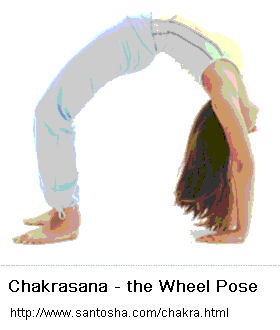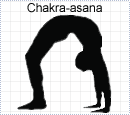sa064b1-2.htm
from: Online Sanskrit Dictionary, February 12, 2003 . http://sanskritdocuments.org/dict/dictall.pdf 090907
Downloaded, set in HTML, and edited by U Kyaw Tun, M.S. (I.P.S.T., U.S.A.), and staff of TIL Computing and Language Centre, Yangon, Myanmar. Not for sale. No copyright. Free for everyone.
index.htm | Top
SED-con-r2-indx.htm
UKT notes
• • Chakrasana - the wheel pose
• च (cha)
Skt: च (cha) - and - OnlineSktDict
Skt: च ca - indecl. and - SpkSkt
Skt: ca 2 - ca ind. and, both, also, moreover, as
well as
(= ?, Lat. que, placed like these particles as an enclitic after
the word which
it connects with what precedes - MonWilliWash
Pal: ca conj. and, but, even - UPMT-PED089
Pal:
![]() {sa.}
{sa.}  -
UHS-PMD0378
-
UHS-PMD0378
Complete entry in MonWilliWash
Skt: ca 2 - ca ind. and, both, also, moreover, as well as (= ?,
Lat. que, placed like these particles as an enclitic after the word
which it connects with what precedes
# when used with a personal pronoun this must appear in its fuller
accented form (e.g. táva ca máma ca [not te ca me ca], 'both
of thee and me'), when used after verbs the first of them is accented
Pāṇ.
8-1, 58 f # it connects whole sentences as well as parts of sentences # in
RV.
the double ca occurs more frequently than the single (e.g. aháṃ ca
tváṃ ca, 'I and thou', viii, 62, 11) # the double ca may also be
used somewhat redundantly in class. Sanskṛit (e.g. kva hariṇakānāṃ jīvitaṃ
câtilolaṃ kva ca vajra-sārāḥ śarās te, 'where is the frail existence, of
fawns and where are thy adamantine arrows?'
Śak.
i, 10) # in later literature, however, the first ca is more usually
omitted (e.g. ahaṃ tvaṃ ca), and when more than two things are
enumerated only one ca is often found (e.g. tejasā yaśasā lakṣmyā
sthityā ca parayā, 'in glory, in fame, in beauty, and in high position'
Nal.
xii, 6) # elsewhere, when more than two things are enumerated, ca is
placed after some and omitted after others (e.g. ṛṇa-dātā ca vaidyaś ca
śrotriyo nadī, 'the payer of a debt and a physician and a Brāhman
and a river'
Hit.
i, 4, 55) # in Ved. and even in class. Sanskṛit [Mn.
iii, 20 ; ix, 322
Hit.],
when the double ca would generally be used, the second may occasionally
be omitted (e.g. indraś ca soma, 'both Indra and thou Soma'
RV.
vii, 104, 25 # durbhedyaś câśusaṃdheyaḥ, 'both difficult to be divided
and quickly united'
Hit.
i) # with lexicographers ca may imply a reference to certain other
words which are not expressed (e.g. kamaṇḍalau ca karakaḥ, 'the word
karaka has the meaning 'pitcher' and other meanings') # sometimes
ca is = eva, even, indeed, certainly, just (e.g. su-cintitaṃ
câuṣadhaṃ na nāma-mātreṇa karoty arogam, 'even a well-devised remedy does
not cure a disease by its mere name'
Hit.
# yāvanta eva te tāvāṃśca saḥ, 'as great as they were just so
great was he'
Ragh.
xii, 45) # occasionally ca is disjunctive, 'but', 'on the contrary',
'on the other hand', 'yet', 'nevertheless' (varam ādyau na cântimaḥ,
'better the two first but not the last'
Hit.
[Page 380, Column 2] # śāntam
idam āśrama-padaṃ sphurati ca bāhuḥ, 'this hermitage is tranquil yet my arm
throbs'
Śak.
i, 15) # ca-ca, though-yet
Vikr.
ii, 9 # ca-na ca, though - yet not
Pat.
# ca - na tu (vḷ. nanu), id., Mālav-. iv, 8 # na
ca - ca, though not - yet
Pat.
# ca may be used for vā, 'either', 'or' (e.g. iha câmutra
vā, 'either here or hereafter'
Mn.
xii, 89 # strī vā pumān vā yac cânyat sattvam, 'either a woman or a man
or any other being'
R.),
and when a neg. particle is joined with ca the two may then be
translated by 'neither', 'nor' • occasionally one ca or one na
is omitted (e.g. na ca paribhoktuṃ nâiva śaknomi hātum, 'I am able
neither to enjoy nor to abandon'
Śak.
v, 18 # na pūrvâhṇe nā ca parâhṇe, 'neither in the forenoon nor in the
afternoon') # ca-ca may express immediate connection between two acts
or their simultaneous occurrence (e.g. mama ca muktaṃ tamasā mano manasijena
dhanuṣi śaraś ca niveśitaḥ, 'no sooner is my mind freed from darkness than
a shaft is fixed on his bow by the heart-born god', vi, 8) # ca is
sometimes = cêd, 'if' (cf.
Pāṇ.
8-1, 30 # the verb is accented)
RV.
AV.
MBh.
Vikr.
ii, 20
Bhartṛ. ii, 45 # ca may be used as an expletive (e.g. anyaiś ca
kratubhiś ca, 'and with other sacrifices') # ca is often joined to
an adv. like eva, api, tathā, tathâiva, &c.,
either with or without a neg. particle (e.g. vairiṇaṃ nôpaseveta sahâyaṃ
caiva vairiṇaḥ, 'one ought not to serve either an enemy or the ally of an
enemy'
Mn. iv, 133) # ( See eva, api, &c.) For the meaning of
ca after an interrogative See 2. ká, 2. kathā́, kím,
kvá) ; [cf. ?, Lat. que, pe (in nempe &c.) ;
Goth. uh ; Zd. ca ; Old Pers. cā.] -2
• चंद्रमा
(cha..ndramaa)
Skt: चंद्रमा
(cha..ndramaa) - (Fem.nom.S) the moon - OnlineSktDict
• चंद्रमाः
(cha.ndramaaH)
Skt: चंद्रमाः
(cha.ndramaaH) - the Moon god - OnlineSktDict
• चकार (chakaara)
Skt: चकार (chakaara) - did (past perfect tense of kRi +
kar to do) - OnlineSktDict
• चकास्तु
(chakaastu)
Skt: चकास्तु
(chakaastu) - let it be shining - OnlineSktDict
• चक्र (chakra)
Skt: चक्र (chakra) - circle,
wheel, psychic centre in humans - OnlineSktDict
Pal: cakka n. a wheel, circle, disc,
army, multitude, region, domain - UPMT-PED089
Pal: ![]() {sak~ka.}
{sak~ka.}
![]() -
UHS-PMD0378
-
UHS-PMD0378
UKT note: Wikipedia links to the Tantric chakras : Sahasrara , Ajna , Vishuddha, Anahata , Manipura , Swadhisthana , Muladhara , Bindu - UKT 110420
• चक्रं (chakraM)
Skt: चक्रं (chakraM) - cycle - OnlineSktDict
• चक्रबन्ध
(chakrabandha)
Skt: चक्रबन्ध
(chakrabandha) - wheel pattern, a form of bandha poetry - OnlineSktDict
• चक्रम् (chakram.h)
Skt: चक्रम् (chakram.h) - (n) wheel, cycle,
circle - OnlineSktDict
• चक्रवातः
(chakravaataH)
Skt: चक्रवातः
(chakravaataH) - m. cyclone - OnlineSktDict
Pal: cakkavāta m. the whirl-wind - UPMT-PED089
Pal:
![]() {sak~ka.wa-ta.}
{sak~ka.wa-ta.}
• चक्रहस्तं
(chakrahastaM)
Skt: चक्रहस्तं
(chakrahastaM) - disc in hand - OnlineSktDict
• चक्राअकार
(chakraaakaara)
Skt: चक्राअकार
(chakraaakaara) - (bauvriihi) wheel-shaped - OnlineSktDict
• चक्रासन
(chakraasana)
Skt: चक्रासन
(chakraasana) - the wheel posture - OnlineSktDict
See my note on Chakra-asana - The Wheel Pose
• चक्रिणं
(chakriNaM)
Skt: चक्रिणं
(chakriNaM) - with discs - OnlineSktDict
• चज्चलं
(chaJNchalaM)
Skt: चज्चलं
(chaJNchalaM) - flickering - OnlineSktDict
• चञ्चलत्वात् (chaJNchalatvaat.h)
= च ज ् च ल त ् व ा त ्
Skt: चञ्चलत्वात् (chaJNchalatvaat.h)
- to being restless - OnlineSktDict

From: http://www.santosha.com/chakra.html 100628
 Chakra,
from the root cak ("to move") means wheel and therefore this is the Wheel
Posture.
Chakra,
from the root cak ("to move") means wheel and therefore this is the Wheel
Posture.
The cakra-asana is also known as the urdhva-dhanurasana. Urdhva
means raised, elevated or upright and dhanur means bow. Both "wheel
posture" and "raised bow posture" describe the appearance of this asana.
Pronunciation: chah-krah-sa-na
Difficulty: (8) (full variation), (3) (bridge variation)
1. Lie flat on the back in the shava-asana.
2. While exhaling bend the knees and bring the feet as close to the buttocks as possible with the soles of the feet flat on the floor.
3. Bend the arms at the elbows and place the palms of the hands flat on the floor directly under each shoulder with the fingers pointing toward the back.
4. While inhaling slowly, begin to raise the head, back and buttocks off the floor while arching the spine. Continue to press downward on the hands and feet while raising the hips and stomach as high as possible.
First and foremost is the strength and suppleness it restores to the spine. It strengthens the arms, shoulders and upper back as well and stimulates the cardiovascular system. The chakra-asana has an overall tonic effect for the entire body.
As the natural suppleness of the spine is restored after a period of practice you can begin to perfect the form of this asana and thus experience greater benefits.
First be certain that the arms are as straight as possible with very little to no bend in the elbows. When you can hold this comfortably, begin breathing through the nostrils while holding the posture and attempt to get a greater arch in the spine by bringing your hands closer to your feet and/or bringing your feet closer to your hands. Finally, you can extend the duration of the chakra-asana by doing several repetitions in sequence without resting in-between. As you return from the posture keep the hands behind the shoulders and the soles of the feet flat on the floor and as soon as the back returns to floor immediately raise it and enter the full posture again.
The chakra-asana is either held for the duration of the inhaled breath or between one and three minutes while breathing gently through the nostrils. Repeat it two or three times.
 Although
this variation is much easier to perform than the full chakra-asana, it
shares several of its benefits. In particular it will help to stretch the spine
and relieve tightness in the upper back and shoulder area.
Although
this variation is much easier to perform than the full chakra-asana, it
shares several of its benefits. In particular it will help to stretch the spine
and relieve tightness in the upper back and shoulder area.
To get the full benefit of the bridge variation continual effort should be applied to raising the back upward and creating the greatest possible arch with the spine.
While holding the bridge breath slowly through the nostrils. If there is no discomfort felt in the spine or shoulders then one should advance to the full variation of the chakra-asana as described above. Both variations strengthen the back and promote flexibility of the spine. Tightness in the back and spine results from poor posture, stress, a sedentary lifestyle and/or emotional disturbances. You should begin to feel the tightness being released after just a few repetitions.
Go back chakrasana-note-b
End of TIL file